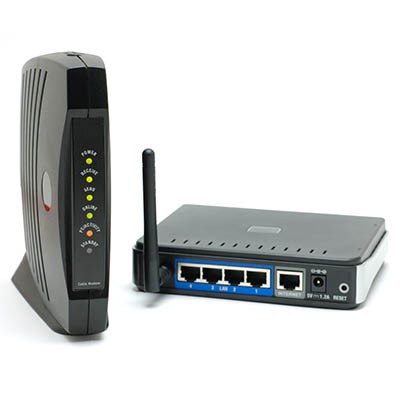
KB Technologies Blog
KB Technologies has been serving the Deerfield Beach area since 2002, providing IT Support such as technical helpdesk support, computer support, and consulting to small and medium-sized businesses.
Routers and Modems… Why Do I Need Both?
The router and the modem are both integral parts of any wireless network. However, not many people entirely understand the role each plays in their Internet connection. To revise this, we will examine the two devices and how they fit into your wireless network.
The router and modem are essential devices for internet connectivity, but they serve different purposes.
The Modem
Function - A modem (short for modulator-demodulator) connects your home network to the wider internet. It translates your Internet Service Provider’s (ISP) signal into a digital signal that your devices can understand.
Connection -The modem is connected directly to the ISP via a coaxial cable (if using a cable modem), telephone line (if using a DSL modem), or fiber optics.
IP Address - Your ISP assigns each modem with a public IP address, which allows it to communicate with the Internet.
Types - DSL, cable, fiber, and satellite modems, depending on the type of internet service you have.
The Router
Function - A router distributes the internet connection from the modem to multiple devices, either wirelessly (Wi-Fi) or through Ethernet cables. It creates a local network for devices in your home or office.
Connection - The router connects to the modem on one side and to your devices (like smartphones, laptops, or smart TVs) on the other side.
Private IP Addresses - It assigns private IP addresses to each connected device, allowing them to communicate while sharing the same public IP provided by the modem.
Additional Features - Routers often include security features (like firewalls), parental controls, guest networks, and more advanced networking options.
What are the Key Differences Between the Two?
As we referenced, these two devices have different functions that contribute to Internet connectivity. The modem connects directly to your ISP to carry the Internet connection to your business or home. Meanwhile, the router takes that connection and creates a local network so multiple devices can connect to the Internet.
But How Do Combo Devices Factor In?
Some devices combine the modem and router into a single unit. While this can simplify the setup of these devices, upgrading or especially troubleshooting is challenging. While standalone routers and modems can be upgraded or replaced separately, these combination devices require you to effectively replace the entire device if something happens to half of it.
The Takeaway
A modem connects you to the Internet. A router creates a network between your devices and the modem to access the Internet.
If your business IT, like your networking equipment, needs an upgrade, turn to the professionals at KB Technologies. Our IT services will provide the best options for your business and help ensure these options remain functional. Give us a call at (954) 834-2800 to get started.
Tired Of Annoying Computer Problems That Keep Coming Back?
Reach Out Today!
Mobile? Grab this Article!
Tag Cloud
Data Recovery
Workplace Tips
Data
Disaster Recovery
Phishing
Security
Backup
Mobile Device
Innovation
Current Events
Business Computing
Saving Money
Software
Business
Privacy
Workplace Strategy
Hardware
Productivity
Microsoft
Malware
Tip of the Week
IT Services
Network Security
Google
Quick Tips
Technology
Managed IT Services
Hackers
Best Practices
User Tips
Hosted Solutions
Users
Cybersecurity
Internet
Email
Efficiency
Collaboration
Cloud
IT Support
Ransomware
Latest Blog
Understanding the Ever-Evolving Threat Landscape In today's digital world, cyber threats are more sophisticated and frequent than ever. Think of the internet as a vast ocean; beneath the surface lurk unseen dangers, constantly evolving and adapting. Are you prepared to navig...
Latest News
KB Technologies is proud to announce the launch of our new website at http://www.kb-it.com. The goal of the new website is to make it easier for our existing clients to submit and manage support requests, and provide more information about our services for ...


Comments